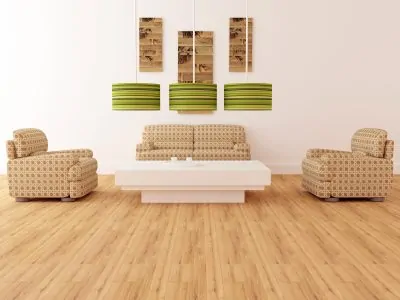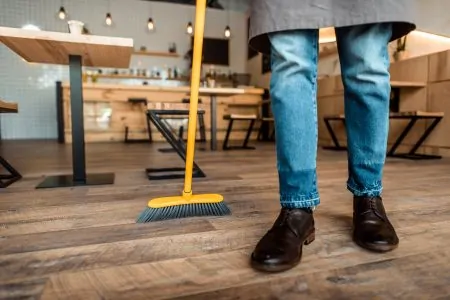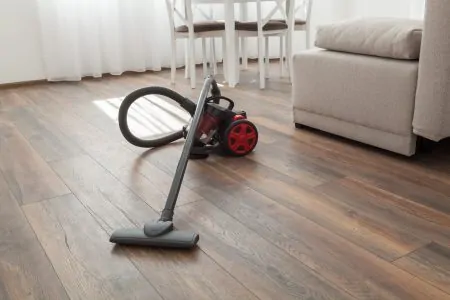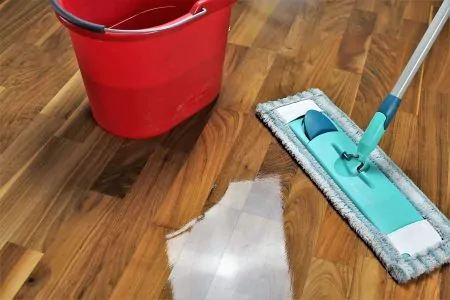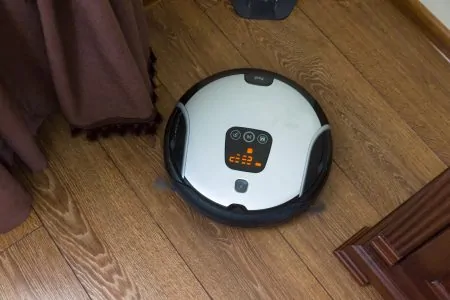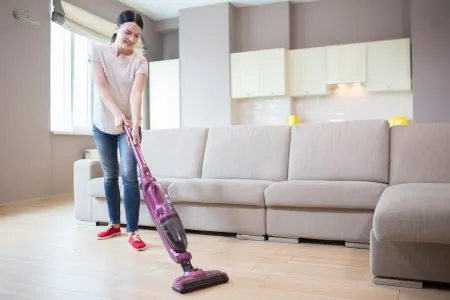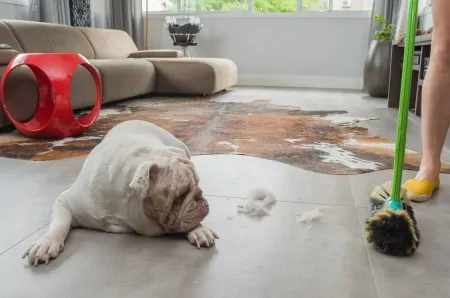There’s no doubt that bamboo floors are a chic, contemporary addition to your home. They’re also an eco-friendly flooring choice. Unfortunately, if you don’t maintain them properly, they’ll deteriorate.
So how do you make sure your bamboo floors are a sight for sore eyes rather than an eyesore?
We’ve found the most affordable, effective, and easiest methods for how to clean bamboo floors. This flooring is different from other hardwoods, so keep reading for the best care tips possible.
Key Takeaways
- Bamboo floors are eco-friendly and easy to maintain, but require proper cleaning to avoid damage.
- Use microfiber mops or soft-bristled vacuum attachments to clean bamboo floors without scratching them.
- Stick to pH-neutral, non-abrasive cleaning solutions specifically designed for bamboo or hardwood floors.
- Avoid soaking bamboo floors with water and never use steam mops, as they can cause staining, warping, or weakening.
Solid Bamboo vs. Engineered Bamboo
There are two main types of bamboo flooring: solid and engineered. It’s challenging to tell them apart once they’re installed. But they are produced differently.
Solid bamboo is viewed as pure. Strips of bamboo are cut, dried, and glued together to form planks that are then lined up and installed. These planks are universally set at 5.59 inches by 72.83 inches (1).
Engineered bamboo is similar to the solid variation, but the bamboo strips are fixed to a plywood base first. This foundation adds extra stability and means that the bamboo planks can be set on any subfloor. There’s also more variation, with a greater allowance for the dimensions of the planks.
Engineered bamboo is a bit more expensive since the manufacturing process is longer and slightly more complex. The plywood used as the base adds to the cost of the planks as well.
Other than that, there are no differences in how to treat your floor. They’re used the same way and have the same lifespan. Both types will look the same (with the exception of design) and require the same maintenance.
The Benefits of Bamboo Floors
Technically speaking, although bamboo is seen as wood, it’s actually a type of grass. It serves as an excellent alternative to genuine hardwood flooring and has many advantages over others. Here’s why you should choose it.
1. It’s Eco-Friendly
Hardwood is beautiful, but conservation is a concern that comes with the package. Wood is a renewable resource, but its industry is one of the driving forces of deforestation (2). Trees can be regrown, but it’s a lengthy process that can’t keep up with the rate at which forests are torn down.
On the other hand, Bamboo is the world’s number one renewable resource. It grows at an almost uncontrollable rate of up to four inches a day. Cutting it improves the structure of the plant as a whole and so is encouraged.
2. Multi-Purpose
Bamboo isn’t waterproof but compared to other hardwoods, it does have a higher water-resistance. This makes it a versatile option that you can install in almost any area of your house.
It even works well in the kitchen. Spills won’t affect it as significantly or quickly as they will true hardwoods. The rule of thumb is that puddles or messes won’t damage your bamboo floor if they’re cleaned within 24 hours. Smaller drops of water will evaporate without leaving unsightly watermarks in their wake.
Quick Tip
3. Easy Maintenance
Maintaining a bamboo floor is easy and affordable. You don’t need special equipment, and it’s easy to grasp the cleaning techniques. In fact, you probably already have every cleaning tool you will need.
If all else fails, there are homemade solutions you can try using items in your kitchen and good old tap water.
4. Budget-Friendly
The initial costs of bamboo are lower than genuine hardwood (3). So if you dream of wood floors but aren’t looking forward to investing in them, bamboo is the best alternative. You’ll have the same sophisticated look and feel of wood at a fraction of the price.
If you take good care of your bamboo floor, it will last decades. Installation — or reinstallation — is also easy. If you’re handy, you might not even have to hire professionals, saving you a good amount of money.
5. It’s Stronger
Bamboo is sturdier and, therefore, more durable than hardwood. One study even notes that it trumps oak in stability (4). If you have a busy home and need that extra sense of solidity, bamboo is a wise choice.
This ties back into the costs of bamboo. Its strength spells out fewer repairs and replacements for you, lowering its overall costs.
Be Gentle
The Best Cleaning Tools for Bamboo Floors
Although maintaining your bamboo floor isn’t difficult to do, if you don’t do it correctly, you could accidentally damage it. So what’s safe to use on your floors in your quest to keep them pristine?
Which Solutions Can You Use on Bamboo?
When it comes to chemical cleaners, you can try a few things. Both store-bought and homemade options are effective, so it’s a matter of personal preference.
How to Clean Bamboo Floors
Ultimately, it doesn’t matter whether you choose to use tools or your bare hands, chemical cleaners, or DIY mixes. The technique is what makes the difference between abrasions, dents, and water damage and a pristine bamboo floor. Here’s what you should be doing to make the most of your cleaning:
Light Cleaning
- Time: 20 minutes
- Difficulty: Easy
1. Sweep
Before you do anything else, gently remove dirt and dust from your floor by sweeping it. You can opt to vacuum or dry mop instead. In each case, be sure to use the appropriate tools, like microfiber heads, soft bristles, or hard floor cleaning attachments.
2. Spritz
Choose your favorite cleaner and spritz some onto your floor as you go. Don’t try to cover as much ground as possible. You want to spritz and then wipe immediately in gentle circular motions with a dry or slightly damp cloth or mop.
Leaving chemical cleaners to stand, even homemade ones, could cause streaking or, even worse: moisture damage.
3. Pat Dry
If you notice excess moisture, whether from water or a cleaning solution, dry it as quickly as possible. The best way to do this (if you’re not using a mop) would be to take a soft, preferably microfiber cloth and pat it dry. You can use this method for spills too.
Deep Cleaning
Don’t think of bamboo floors as you would a carpet or tiles. They don’t need deep cleaning in the usual sense — doing so may damage their finish. The method is much the same for tough stains, scuff marks, or disinfecting your floors.
Once you have swept, vacuumed, or mopped, the only extra step you have to take is to spot clean.
- Time: 30 minutes
- Difficulty: Easy/Intermediate
1. Target Stains
Using your chosen solution, spritz some of it directly onto the stain. It’s important to follow the manufacturer’s directions when using chemical cleaners. Some can be left to work for a few minutes, while others cannot.
When using a homemade remedy, it’s best to treat it as you would water, wiping it up as soon as possible.
Check that your store-bought cleaner has sanitizing properties. If not, the recommended vinegar solution will do the trick.
2. Rub Gently
Once you’ve applied your cleaner, take your cloth and gently rub the mark or stain. Use the same circular motions for the best effect. Don’t use harsh brushes, scrubbers, or abrasive tools for stain removal.
If your stains are deep-set, multiple treatments might be necessary before you notice a difference. In some cases, stains could be too embedded and so, unfortunately, impossible to get rid of without replacing the bamboo.
Quick Tip
Reviving Bamboo Floors
Sometimes a broom or cloth won’t fix the damage on your bamboo floor. If that’s the case, you’ll have to buy specialized products to restore its sheen:
- Use cleaners: There is a multitude of products available that will shine your floors. Be cautious when choosing them, though, as polishes and waxes will leave a residue and may make your floors slippery. Stick to the hardwood cleaners that are pH balanced, but look out for those with restoring properties.
- Stop using vinegar: Many happy cleaners speak for vinegar, but the truth is that it may be the problem. Stop applying vinegar immediately if you notice that your floors have dulled over time. Prevention is better than remedy, so take precautions to preserve your bamboo.
- Rescreen: Bamboo lasts a while when treated with care, but inevitably, you will have to replace it. Rescreening means that only the top layer of the finish is removed and replaced. It’s easier, saves time, and will cost less if you call in the professionals.
- Refinish: If you want to restore your bamboo floor fully, a little more effort will be required. Refinishing means removing all layers of your finish, and your bamboo is sanded down before adding a new finish.
- Replacement: If your bamboo is damaged beyond repair, you will have to replace it entirely. On the upside, remember that bamboo is one of the most affordable wood floors you can buy, so that revamping won’t cost a fortune.
FAQs
Don’t Be Bamboozled
See? There’s little effort involved in maintaining bamboo floors. Unlike others of its kind, cleaning and preservation are almost effortless. The best thing you can do is treat it with care from the start.
This way, you’ll ensure that no unsightly or irreparable damage is done. You’ll also save time and effort in your daily and weekly runs. Simply sweep dirt daily and mop with your favorite cleaner weekly, and your floors should stay pristine.
